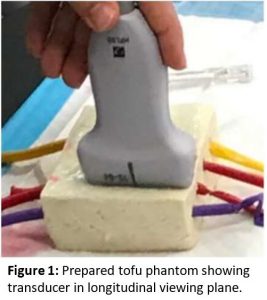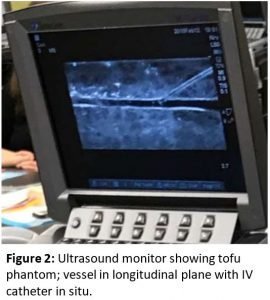Developed and created by Campbell University’s Emergency Medicine Club
Andrew Langille, Kansas City University, OMS-III
Contributors: Zachary Mauro, CUSOM OMS-III; Jeffrey Davis CUSOM OMS-III; Brian Conner, CUSOM OMS-III
Intravenous (IV) access is an essential procedure that can be difficult under certain circumstances in the emergency department. Providers are now using ultrasound to better visualize vasculature to gain IV access in patients that are difficult sticks. Acquiring this skill requires an experienced educator and a realistic, yet safe model. Moreover, creating effective and clinically relevant events can be costly and outside of budget for clubs run by medical students. Campbell University’s emergency medicine club has recently developed a cost-effective and realistic US guided IV access phantom for a hands-on clinic. With these instructions, you can now quickly build phantoms for less than $4.00 each and learn a skill that applies to all fields of medicine.
Making a Phantom
What you need:
- 4 longitudinal latex balloons
- 1 L of tap water
- 1 bottle red food coloring
- 1 block of firm or extra firm tofu
- 1 chopstick or wooden dowel
- 1 Chux absorbent pad
- IV catheters (3-5 cm preferred)
- Ultrasound machine with linear array transducer


Instructions for construction:
- Prepare a solution of 1 L tap water and 3 mL of red food coloring.
- Fill each balloon with approximately 8 cc of prepared solution. Avoid overfilling. Tie off the end and tie again at half the length of the balloon (allows for 2 attempts).
- Place the end of the chopstick into the cuff of the balloon and hold balloon parallel to the chopstick.
- Locate a space approximately 1-2 cm from tofu edge and insert the balloon and chopstick through the tofu.
- Once the end of the balloon is visible on the other side grasp the balloon with your other hand and retract the chopstick.
- Cover and store in a refrigerator until ready to use. Tofu will become firmer and less fragile overnight.
For video instructions click here or follow the link below!
How it Works:
Under ultrasound visualization, tofu displays a non-uniformly echogenic background, much like that of human tissue. The fluid-filled balloon is largely anechoic simulating that of vasculature. The balloon allows for proper compressibility testing as well as tenting and “bullseye” sign when performing the procedure.
Steps to IV placement:
- A prepared phantom is placed at each US machine.
- Visualize the vessel both in a transverse and longitudinal view.
- In a transverse plane, center the vessel to the probe and screen.
- The depth of the vessel is determined and the catheter is inserted at a 45 degree angle that same distance away from the probe.
- Advance the IV catheter and follow with US probe until tenting of the vessel is witnessed.
- Continue a few millimeters until a “bullseye sign” is seen. At this point you should have “flash” and the catheter can be advanced.
(This technique can also be applied using the longitudinal plane; however, advancing the US probe with the catheter is not required since you are able to visualize the entire needle.)


When performing the skill on patients, be sure to use a tourniquet, clean insertion area with an alcohol pad, and secure with a saline lock.
Cost for 1 block:
| Item | Price |
|---|---|
| Block of tofu | $2.50 |
| Balloons | $0.40 per 4 balloons ($10.00 / 100 ct.) |
| Chop Stick | $0.10 |
| Chux Pads | $0.25 each |
| Red Food Coloring | $0.20 per 3 mL ($8.00 / 4.5 oz.) |
| Tap Water | Free |
| US Machine | Use at home institution |
| 3-5 cm IV Catheters | Varies Donation of expired supplies |
| Estimated Total Cost | $3.45 |
